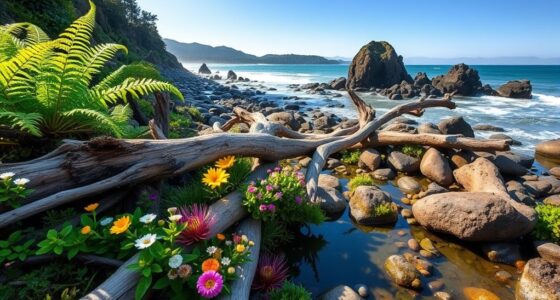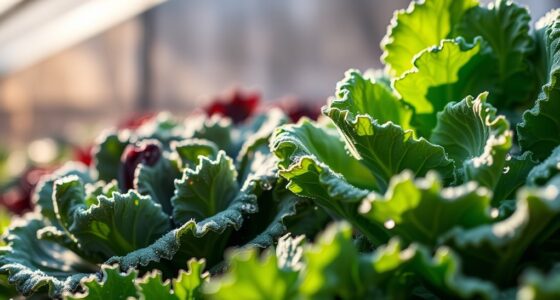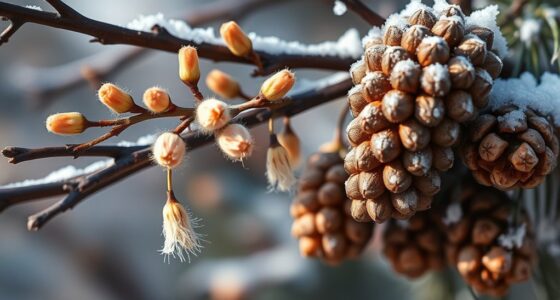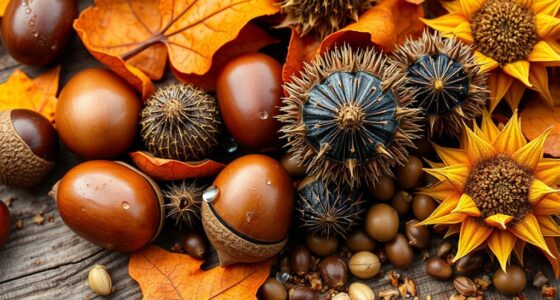In winter, foraging by the sea requires paying close attention to seasonal signals, tide schedules, and weather conditions. Focus on harvesting sustainable seaweed like kelp and wakame during ideal times, and always leave enough behind to support the ecosystem. Stay safe by avoiding harsh weather and dangerous tides, and be mindful of environmental cues that can guide your harvesting. Curious how to master these techniques? Keep exploring for more tips and insights.
Key Takeaways
- Winter foraging requires understanding seasonal cycles and tidal patterns to access edible seaweeds and shells safely.
- Use sustainable harvesting techniques, avoiding damage to holdfasts and leaving enough for ecosystem health.
- Low tide conditions provide better access, but always check weather and tide forecasts for safety.
- Recognize environmental cues like seaweed growth signs and water conditions to determine optimal harvesting times.
- Prioritize safety by assessing visibility, weather, and environmental signs to prevent accidents and protect ecosystems.

Have you ever wondered how foragers find edible treasures along the coast during winter? It’s a skill rooted in understanding the land and sea’s natural rhythms, a way to tap into nature’s bounty even when most people see it as dormant. When you explore coastal foraging in winter, you quickly realize that mastering harvesting techniques is essential. These methods aren’t just about grabbing what looks good—they’re about respecting the environment, ensuring sustainability, and maximizing your haul. During colder months, the sea’s offerings change, and seasonal variations come into play. Some seaweeds, like kelp or wakame, thrive in winter’s nutrient-rich waters, making them prime targets for harvest. Knowing when to collect and which species to focus on requires keen observation and knowledge of seasonal patterns. For instance, certain edible seaweeds are more abundant and tender in winter, while others might be tougher or less accessible.
As you venture out, you learn that timing is everything. You don’t just pick seaweed at random; you look for signs of growth and health, ensuring you’re harvesting sustainably. Proper harvesting techniques include cutting only what you need, avoiding damage to the holdfasts—those root-like structures that keep seaweed anchored—and leaving enough behind for the plant to regenerate. This approach keeps the ecosystem healthy and ensures future foraging success. You’ll also discover that tidal patterns and weather conditions influence your harvest. Low tide offers the best access to intertidal zones, but harsh weather can make foraging dangerous. Knowing how to read the sea’s signals and adapt to seasonal variations gives you an edge, making your foraging both productive and safe. Additionally, understanding the contrast ratio of your environment can help you assess the best times for harvesting when visibility and conditions are optimal.
The more you learn, the more you realize that winter foraging isn’t just about collecting food—it’s about connecting with the natural cycles and embracing a liberation from dependence on store-bought provisions. These seasonal shifts teach you to be patient and observant, to respect the environment’s ebb and flow, and to adapt your techniques accordingly. Whether you’re gathering shells or harvesting seaweed, understanding seasonal variations empowers you to forage responsibly and sustainably. It’s a way to reclaim your food source, to live more in tune with nature’s rhythms, and to enjoy the freedom of sourcing your nourishment directly from the sea. Each trip becomes a lesson in harmony, resilience, and self-sufficiency—an act of liberation that feeds both your body and your spirit.
Frequently Asked Questions
Are There Any Legal Restrictions on Winter Seaweed Foraging?
Yes, there are legal restrictions on winter seaweed foraging. You should adhere to seasonal foraging rules and conservation guidelines to safeguard marine ecosystems. Limits on the amount you can collect and protected species exist to ensure sustainability. Check local regulations before gathering seaweed, as laws vary by region. By respecting these rules, you’re helping preserve the coastline’s natural beauty while enjoying the freedom of foraging responsibly.
What Are the Best Tools for Collecting Shells Safely?
You should use handheld trowels and mesh bags to collect shells safely. The trowel helps you gently pry shells from rocks without damaging them, giving you freedom to explore with precision. Mesh bags are perfect for carrying your finds, allowing sand and water to drain while keeping your collection secure. With these tools, you’re empowered to gather shells efficiently and responsibly, embracing the joy of your seaside adventure.
How Can I Identify Edible Versus Toxic Seaweed?
Did you know over 70% of seaweed species are safe to eat? To identify edible versus toxic seaweed, focus on seaweed identification features like color, texture, and smell. Edible varieties often have vibrant, healthy appearances and mild ocean scents, while toxic ones may look dull, slimy, or have strange odors. Trust your instincts, but always cross-reference with reliable guides or local experts to guarantee safe foraging and truly liberate your taste buds.
Is Winter Foraging More Dangerous Than Other Seasons?
Winter foraging can be more dangerous due to seasonal hazards like icy surfaces, colder temperatures, and reduced daylight, making safety precautions essential. You should dress warmly, wear sturdy footwear, and be extra cautious around slippery rocks and tide pools. While the thrill of winter foraging offers liberation, always prioritize safety to avoid accidents. Staying alert and prepared helps you enjoy the season’s bounty without compromising your well-being.
What Are Some Local Regulations I Should Be Aware Of?
Think of the sea as your playground, but remember, marine conservation rules are your guide. You ought to verify local regulations before foraging, as seasonal permits may be required, especially in protected areas. These laws protect marine life and ensure you enjoy your freedom responsibly. Stay informed, respect the environment, and embrace your adventurous spirit while following the rules—your connection to the ocean remains unbroken and pure.
Conclusion
As you navigate the winter shoreline, remember that every foraging adventure brings its own quiet rewards. While the sea offers its treasures, it also gently reminds you to proceed with care and respect. Embrace the subtle dance between discovery and caution, allowing the ocean’s whispers to guide you safely. With patience and mindfulness, you’ll find that the winter coast holds secrets worth the gentle pursuit—treasures that nourish both body and soul.










